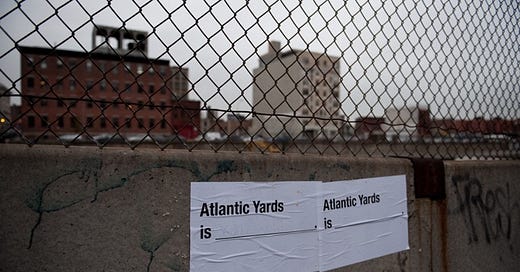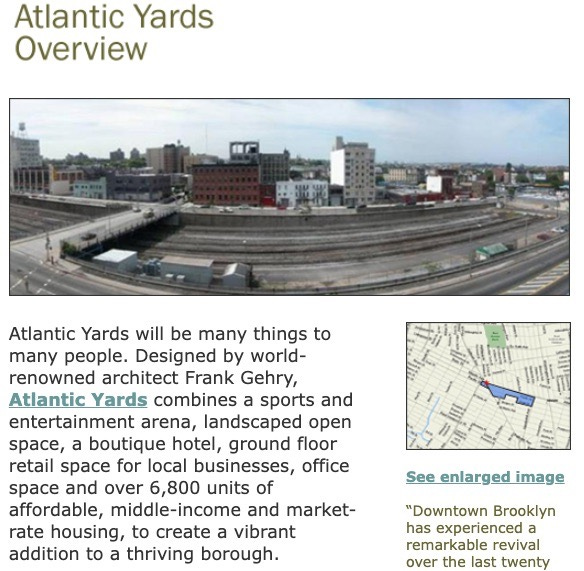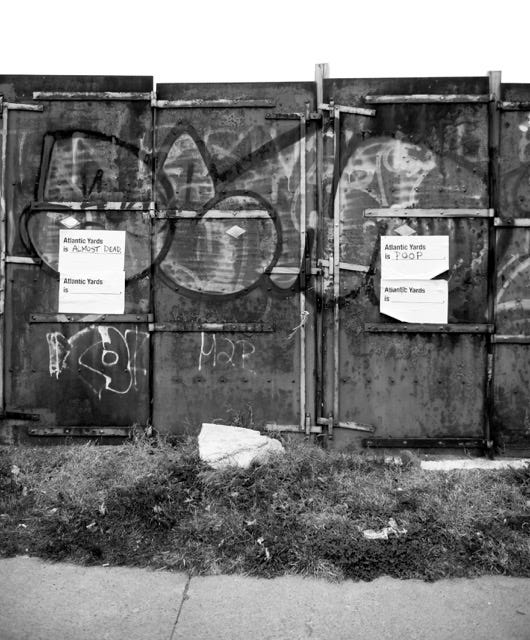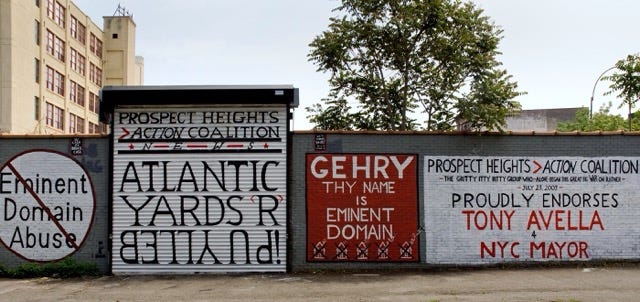A decade ago, citing the uneasy, incomplete transition from the name Atlantic Yards to the newly proclaimed Pacific Park Brooklyn, I suggested another look at a couple of open-ended statements that were unwittingly more meaningful than intended.
For example, consider the screenshot below from the original Atlantic Yards web site--complete with deceptive fish-eye photo suggesting that one block of the three-block MTA railyard, plus a bit more, would be transformed into the entire 22-acre project.
"Atlantic Yards will be many things to many people," it stated. Indeed, it would be so many things it would, in 2014, be officially renamed Pacific Park.
The passage above suggested, unwisely, that the project would be designed “by world-renowned architect Frank Gehry,” who was later dumped, and would include a boutique hotel (not yet, maybe never) and office space (nah). The 6,800 apartments were cut to 6,430—but that could change, again.
The page also used the terms” affordable” and “middle-income” to describe the below-market housing. That precision was lost when all such income-targeted housing was subsumed under the gauzy concept of “affordable,” which merely means tenants pay about 30% of their income.
As shown in the chart below, “affordable” middle-income units—look at the three columns at right, regarding the last four towers constructed—don’t come cheap.
The difficulty of prediction
In my 2014 article, I pointed to the closing paragraphs of a July 1, 2007 New York Times article headlined Official Sees Possible Risk in Big Project in Brooklyn:
Richard Moore, a real estate analyst at RBC Capital Markets, said that Forest City had a reputation for careful planning and very conservative investments. But he also noted that even the most competent developers could not easily predict how a long-term project like Atlantic Yards would turn out.
“I could see this project taking many forms over the years,” Mr. Moore said. “It could go either direction, I imagine.”
That was an understatement. It’s gone in many, many directions.
“Atlantic Yards Is___.”
That makes a Nov. 23, 2009 photo, below, by the invaluable photographic chronicler Tracy Collins, that much more meaningful.
Looking south at the Vanderbilt Yard west of Sixth Avenue to what’s now the arena block, with two condo buildings—renovated industrial structures—nearly emptied before demolition— the photo captures an anonymous (as far as I know) effort to encourage passers-by to fill in the blank: “Atlantic Yards is ______.”
I’m not sure the childish answer “POOP,” at right in photo below, was ever accurate, but “ALMOST DEAD,” at left below, has applied more than once, including, perhaps, late last year, when the six development sites on the Vanderbilt Yard sites entered foreclosure.
But it’s sure not the “Jobs, Housing, and Hoops” as once ballyhooed.
Examples, 2014
As to the observation, “It could go either direction, I imagine,” as of 2014, I offered some quick (but not exhaustive) examples of the perils of prediction.
A shift from office space to condos
Arena block towers decoupled from the arena
A timetable extension to 2035, suggesting a potential 25-year buildout, rather than ten years
A new smaller arena design, aimed for basketball, not major league hockey
A gloss on that new design: a new, pre-rusted metal skin, plus a distinctive oculus
A new majority investor from Russia for the Nets
That same Russian oligarch as a minority investor in the arena
Three separate efforts to raise cheap capital from immigrant investors in China, under the EB-5 investor visa program
A plan aimed to revolutionize construction using modular techniques
A snag in the modular plan, leading to a bitter lawsuit
A major league hockey team, the New York Islanders, moving to the arena
A new majority investor, Greenland USA, owned significantly by the Shanghai government, for the non-arena portion of the project
A new green roof aimed, in part, to deter escaping bass from the Barclays Center.
A new architect for the next towers, which would be built conventionally
A threatened lawsuit, a settlement, and new 2025 deadline for the affordable housing
A new name for the project, though many people still use Atlantic Yards, or Atlantic Yards/Pacific Park, and New York State still calls it the “Atlantic Yards Land Use Improvement and Civic Project”
Forest City's share of the team up for sale
Forest City’s share of the arena up for sale
Belly up?
The project didn’t quite go “belly up,” as suggested in the second-to-left panel of the Prospect Heights Action Coalition’s messages below, at the corner of Carlton Avenue and Dean Street, which Collins photographed May 27, 2008.
After all, there’s a new building, 535 Carlton, at that location.
But it’s come pretty darn close.
Examples, 2024
A decade, I observed, “Don't be surprised at some unexpected change. Indeed, “Atlantic Yards is a never-say-never project” is one of my project mantras.
Indeed, let’s count the multiple “directions” in which the project has gone since then:
Only one condo building gets built
Forest City exits the project almost completely, and the parent company is absorbed into Brookfield
The flagship tower, aka “Miss Brooklyn,” is not built, though developer Greenland seeks to shift the bulk across Flatbush Avenue to Site 5, creating a giant two-tower project
The New York Islanders exercise their opt-out clause and return to Nassau County, eventually getting their own arena
Joe Tsai emerges as the new owner of the Nets and arena company
The arena plaza, at least/especially in 2020, as an “accidental town square”
Tsai launches a $50 million Social Justice Fund, over ten years, in response to the racial reckoning of 2020, though accounting is murky
The plaza is now on its fourth sponsor, Ticketmaster
Arena operators trade 30 suites for new club space
The WNBA’s New York Liberty is bought by Tsai, and achieve a championship this year
A new minority owner, the family of the notorious right-winger David Koch, enters, as Tsai’s BSE Global skyrockets in value
Forest City’s modular plan does not revolutionize construction
Two local firms, The Brodsky Organization and TF Cornerstone, build three towers, plus Brodsky built—and took the lead in—a fourth tower
New architects and landscape architects emerge for each project
The “affordable housing” is skewed toward middle-income households, hardly stemming gentrification, as initially billed
A likely effort to extend the timetable past 2035
A likely effort to extend the affordable housing deadline past 2025
The failure to pay back two EB-5 fundraising efforts puts Greenland USA’s rights to six railyard development sites in foreclosure
The likely departure of Greenland, at least for the six tower sites in foreclosure, and the expected entry of Related Companies, part of a new joint venture with Fortress Investment Group and the U.S. Immigration Fund
Completed buildings sold to new owners: 461 Dean to Principal Global Investors and 38 Sixth and 535 Carlton to Avanath Capital
An Atlanta office project takes the name Atlantic Yards
Tsai’s BSE Global buys Brooklyn Magazine and pursues a new Brooklyn “ecosystem”—not just media but a hotel, basketball clinics, a share in the revived Brooklyn Paramount, and even a marquee retail space at the base of the landmark Williamsburgh Savings Bank tower
The bottom line
“Atlantic Yards will be many things to many people.” That was true.
Will there be a new name for the project? I’d bet yes, and even suggested “Brooklyn Central.”
Will there be a renegotiation of project terms, opportunities, and obligations? Sure.
Will that serve the public interest? We’ll see, but the pattern hasn’t been encouraging.
Will the project ever get finished? Well, probably not by 2035, the current “outside date.”
Will the taint of “Atlantic Yards” remain? For some, sure. But time, and new public relations efforts, can reshape perceptions.








